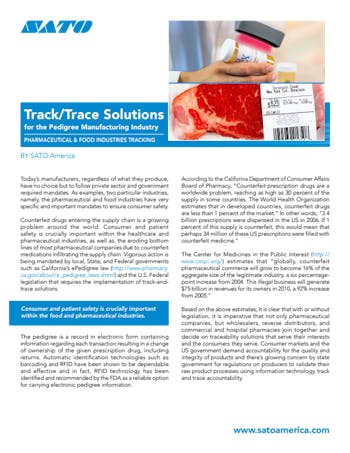Today’s manufacturers, regardless of what they produce, have no choice but to follow private sector and government required mandates. As examples, two particular industries, namely, the pharmaceutical and food industries have very specific and important mandates to ensure consumer safety.
Counterfeit drugs entering the supply chain is a growing problem around the world. Consumer and patient safety is crucially important within the healthcare and pharmaceutical industries, as well as, the eroding bottom lines of most pharmaceutical companies due to counterfeit medications infiltrating the supply chain. Vigorous action is being mandated by local, State, and Federal governments such as California’s ePedigree law (http://www.pharmacy. ca.gov/about/e_pedigree_laws.shtml) and the U.S. Federal legislation that requires the implementation of track-andtrace solutions.
The pedigree is a record in electronic form containing information regarding each transaction resulting in a change of ownership of the given prescription drug, including returns. Automatic identification technologies such as barcoding and RFID have been shown to be dependable and effective and in fact, RFID technology has been identified and recommended by the FDA as a reliable option for carrying electronic pedigree information.
According to the California Department of Consumer Affairs Board of Pharmacy, “Counterfeit prescription drugs are a worldwide problem, reaching as high as 30 percent of the supply in some countries. The World Health Organization estimates that in developed countries, counterfeit drugs are less than 1 percent of the market.” In other words, “3.4 billion prescriptions were dispensed in the US in 2006. If 1 percent of this supply is counterfeit, this would mean that perhaps 34 million of these US prescriptions were filled with counterfeit medicine.”
The Center for Medicines in the Public Interest (http:// www.cmpi.org/) estimates that “globally, counterfeit pharmaceutical commerce will grow to become 16% of the aggregate size of the legitimate industry, a six percentagepoint increase from 2004. This illegal business will generate $75 billion in revenues for its owners in 2010, a 92% increase from 2005.”
Based on the above estimates, it is clear that with or without legislation, it is imperative that not only pharmaceutical companies, but wholesalers, reverse distributors, and commercial and hospital pharmacies join together and decide on traceability solutions that serve their interests and the consumers they serve. Consumer markets and the US government demand accountability for the quality and integrity of products and there’s growing concern by state government for regulations on producers to validate their raw product processes using information technology, track and trace accountability.
The decision making of traceability solutions falls onto the individual corporation and the stakeholders they serve. Consumer markets and the US government demand accountability in the wholesomeness of product and there’s growing concern by state government for regulations on producers to validate their raw product processes using information technology, track and trace accountability.
However, a major challenge for both industries is that years and years of paper trail detail produces an overwhelming amount of data for one producer to keep track of, yet alone the man hours associated with keeping the data captured organized and useable. When coupled with the number of manufacturers who “touch” a single ingredient used to manufacturer the final product, the task of gathering this information is daunting to say the least. As a result, careful attention must be paid to the managing of the information collected and the effective transfer of information along the supply chain.
Each participant in the chain must come to the conclusion to invest in the automated process of trace/track accountability, as they are stakeholders in the overall process of finished product and will be accountable for their part. From raw ingredients or seedling to processing, from the wholesaler to the pharmacy or from farm to fork, track/trace systems provide visibility and support the company’s validation of their procedures and protocols.
SOME ASPECTS OF A TRACK/TRACE SOLUTION WOULD INCLUDE;
- Tracking import and export elements of raw materials
- Integrating with FDA safety and other processing systems
- Effectively tracking and tracing products both internally and externally
- Documenting product history from manufacturing to the customer
- Providing a supported chain of custody for finished goods
PRODUCT EFFICIENCIES OF TRACK/TRACE SOLUTIONS WOULD INCLUDE;
- Accurately accounting for raw material processes
- Authenticating product at the item/dose level
- Accurately tracing processed products
- Accurately managing recalls
- Accurately managing returns
- Accurately managing distribution of sample products
- Speeding up receiving time
- Speeding up processing time
- Speeding up replenishment time
- Reducing infiltration of counterfeit pharmaceuticals into the supply chain
- Reducing errors
- Providing accurate auditing and inventory forecasting
PRODUCT LOGISTIC AND WAREHOUSING SUPPORT VALUES WOULD;
- Reduces inventory management expenses
- Reduces stock levels
- Reduces manual checks
- Reduces product recall costs
VALUE PROPOSITIONS APPLIED TO FEDERAL, STATE OR LOCAL REGULATORY COMPLIANCE;
- Supports documentation on manufacturing and processes used for any track/trace protocol established by regulatory agencies
- Supports integration guidelines as set by the industry or government regulatory standards
- Supports integration guidelines as set by the industry or government regulatory standards
- Supports a reporting of multi-ingredient traceability
To ensure the integrity of pharmaceutical drugs as they move from manufacturing to the consumer, as well as, to improve the productivity and profitability of all stakeholders, track/ trace solutions including barcoding and RFID technologies must be implemented as soon as possible.
